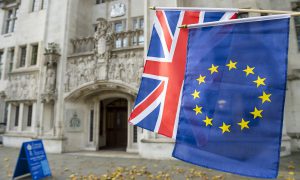
This morning, the UK Supreme Court ruled that Brexit may not go forward unless Parliament votes to authorize withdrawal from the European Union, despite the fact that the motion won a national referendum last year. Here are five facts you need to know about British citizens’ attempt to reassert their sovereignty by leaving the Brussels-based international government body.
1. Brexit passed handily and remains popular in England. Parliament voted in June and December 2015 to allow for a national referendum on Brexit. Last June 23, approximately 72 percent of UK voters took part in the election, voting 52 percent to 48 percent to leave the European Union – primarily over the right to restrict immigration from the rest of the EU. A recent poll found that 53 percent of Brits would support leaving the European Union regardless of the final exit agreement’s details.
2. The Supreme Court ruling does not halt or overrule Brexit. Today’s 8-3 ruling is a procedural issue, not a substantive one. The president of the UK Supreme Court, Lord David Neuberger, said, “The referendum is of great political significance, but the act of Parliament which established it did not say what should happen as a result.” Thus, Parliament must officially vote to trigger Article 50 of the 2007 Lisbon Treaty, allowing member states to leave the EU. “The government cannot trigger Article 50” without an act of Parliament ordering it to do so, Lord Neuberger said. Opponents say this disregards the will of the people, while supporters call today’s decision a victory for parliamentary sovereignty.
3. The Conservative government will act swiftly – but the parliamentary process could greatly slow the process. Brexit Secretary David Davis said he will introduce a bill – possibly only one line long – in Parliament within days, and Prime Minister Theresa May still expects Article 50 to be triggered “by the end of March.” Labour Party leader Jeremy Corbyn said that, while his party “will not frustrate the process,” he wants a vote on the final agreement in order to “prevent the Conservatives using Brexit to turn Britain into a bargain basement tax haven.” Staunch Remainers say that muscular opposition could stall Brexit for up to two years, on top of two-year withdrawal process. Liberal Democrats and the Scottish government want a second national referendum after the final agreement is negotiated, a position favored by only 26 percent of the British people. Fewer, only 12 percent, think Parliament should have final say.
4. Westminster doesn’t have to consult the “devolved” governments: Scotland, Wales, and Northern Ireland. That’s good news for Brexit. While a majority of voters in England and Wales voted Leave (53 percent each); Scotland (62 percent) and Northern Ireland (56 percent) voted to Remain. Nicola Sturgeon, the First Minister of Scotland and leader of the Scottish government, has vowed to introduce 50 “serious and substantive” amendments to the Brexit bill to stall the process.
5. Virtually all Brits want to remain in the European single market, a massive free trade zone that includes both EU and non-EU member nations. A poll found 90 percent of people, regardless of how they voted on Brexit, hoped to remain in the European Economic Area. However, the nation need not remain in the EU to enjoy that access. Three nations – Norway, Iceland, and Liechtenstein – are not part of the EU but enjoy access to the EEA single market as members of the European Free Trade Association (EFTA). A fourth EFTA member, Switzerland, has negotiated numerous bilateral trade agreements (Switzerland) granting most Swiss industries access to the EEA. In 2015, trade with the EU accounted for 44 percent of UK exports (£223.3 billion) and 53 percent (£291.1 billion) of the UK’s imports.
(Photo credit: lazyllama / Shutterstock)

